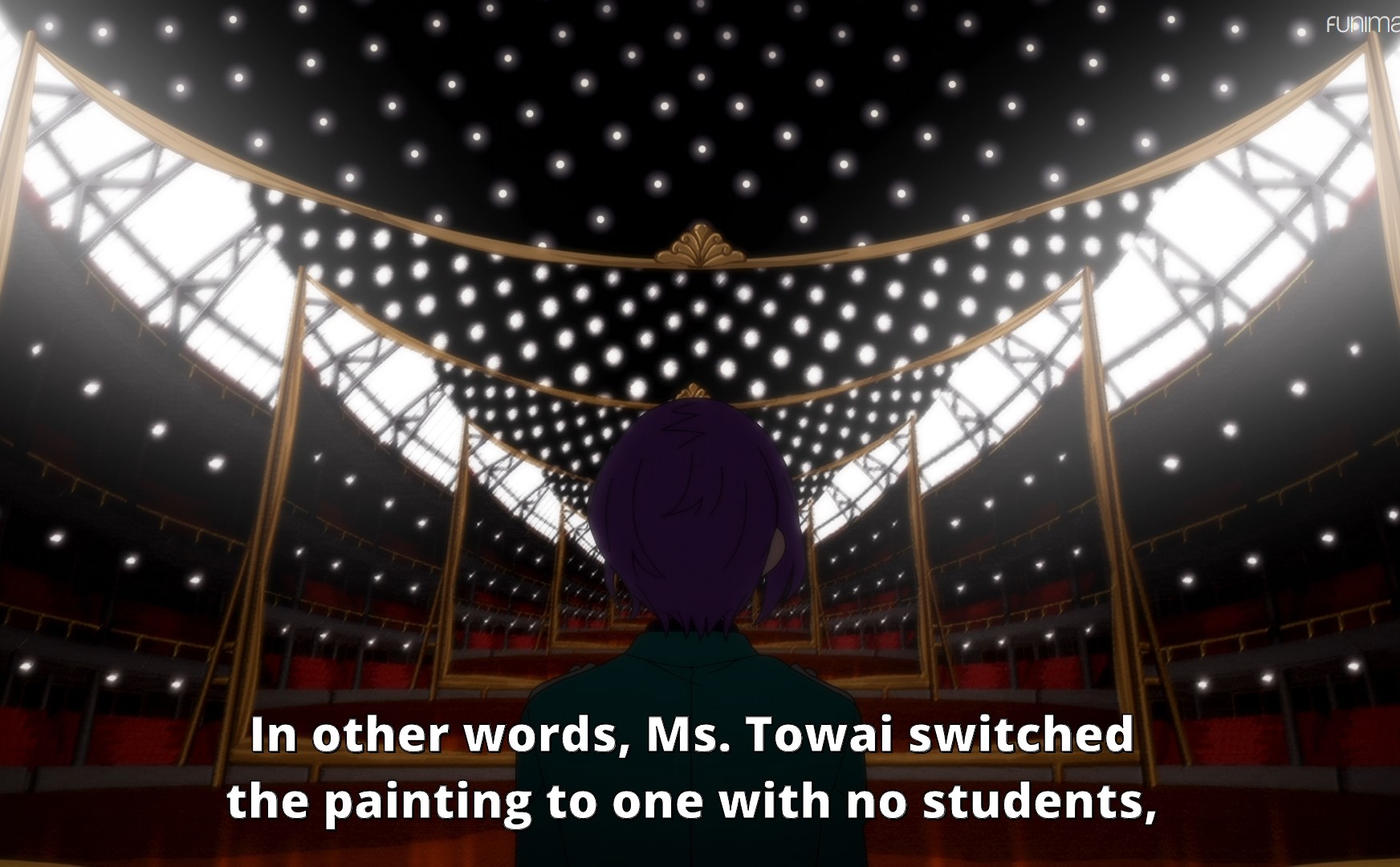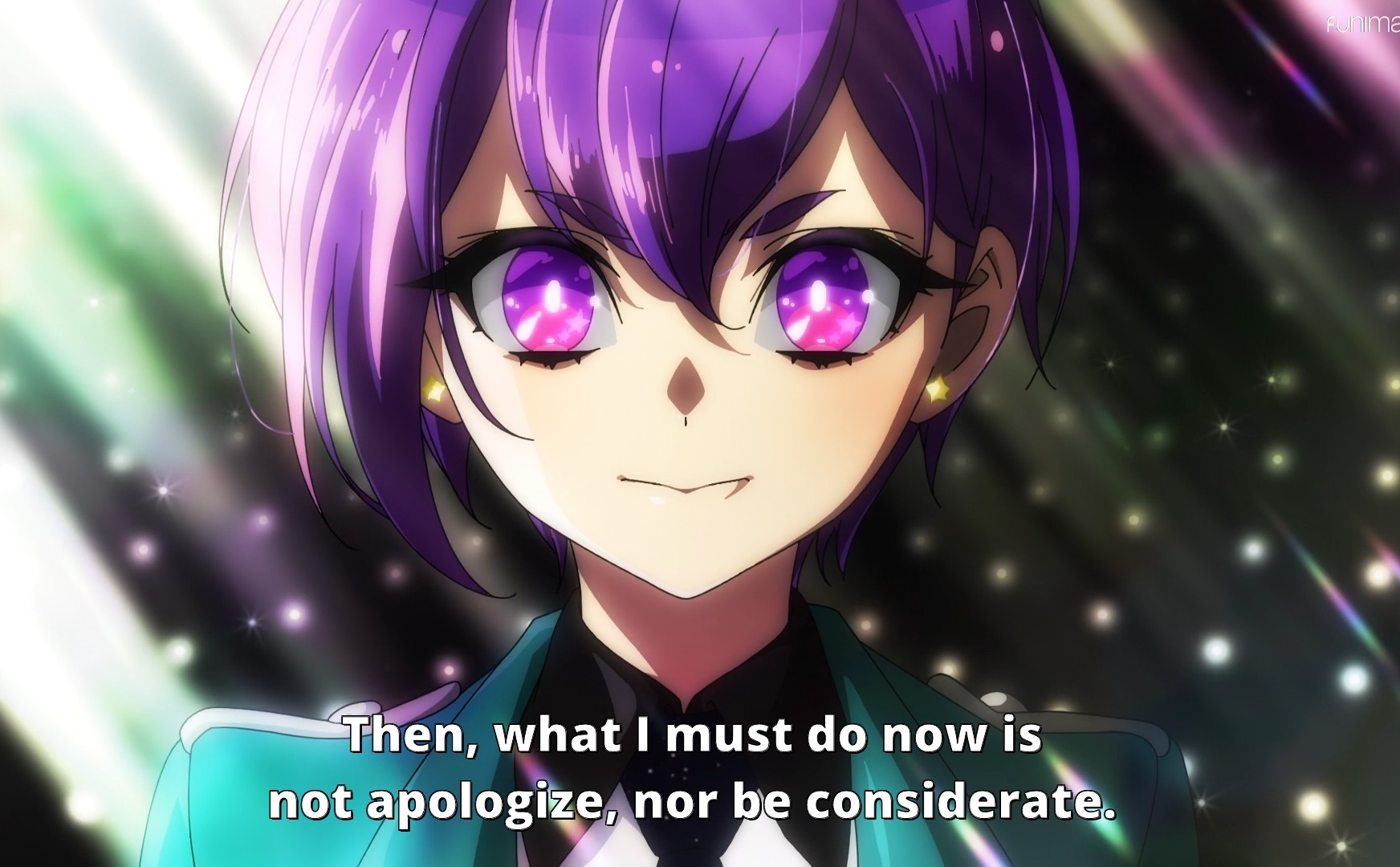In retrospect, this was probably my favourite arc of Pretty Boy Detective Club. At least so far. I’m having the inverse reaction that most people are having, as the show gets increasingly more abstract and really more like a piece of performative art rather than an actual story, I’m liking it more and more. I do think it’s having the opposite effect on some viewers though.












I’ve been following the episode discussion threads on AniList and I do find that a lot of viewers talk about wanting to know more about a particular boy or trying to piece story elements into a greater definite narrative. I don’t think there is a right or wrong way to watch any anime, including Pretty Boy Detective Club. It’s just that when I try to take in the show through the lens of classical character development and narrative constructions, I find it very frustrating. And I would probably find it increasingly frustrating as it was getting more and more allegorical.
These characters are not relatable. I don’t think they are meant to be. After all, they aren’t really characters at all, to begin with. At least to me. I think trying to engage on a direct level with any of them and emotionally resonate with their circumstances and the events that are happening to them would probably turn me off the show.
On the other hand, I do find that emotionally resonating with Pretty Boys Detective Club is very easy for me on a more symbolic level. Like listening to instrumental music. And as I’m unreasonably picky with emotional content, keeping it abstract really suits me well.
This week is a good example. For me, two lines sort of brought out everything it was about. But before we get to those, let’s talk visuals and sound design for a minute.
I really liked the first third. That conversation between Dojima and Fudatsuki in the park captivated me. The colour palette and light changed four times throughout the sequence. Marking the advance of time in an impossible way. As if the terse exchange had lasted from dawn to past nightfall. But also varying with the angle of the camera, creating a visual physical divide between the characters and the speeches they were giving.
I could talk about those visuals a lot more but for once, I’d like to move on to sound. More specifically to dialogue. The exchange between Dojima and Fudatsuki had a few witty lines. He apologized for not living up to expectations 3 times and the camera treated each very differently, but at the climax, Dojima simply stated that her expectations weren’t that high, to begin with. It was great. It subverted the tension built up by the cinematic language in a completely deadpan way all the while creating a playful back and forth between the characters.
But regardless of what the dialogue actually was, what impressed me was the rhythm. Through repeated lines and chosen syllable structure, a beat was created throughout the entire conversation. You could clap your hands to it. I’ve seen this once before in a Visual Novel called Gahkthun and I was amazed by it there as well. Not only is it impressive to create in any fiction but to created in translated work seems like magic to me.











Huh, I was afraid I wouldn’t have anything to say about the episode and I haven’t even gotten to the themes yet…
So here are the two lines that worked for me. The meeting between Dojima and Fudatsuki was not beautiful so it had to be remade into a beautiful reconciliation. This is the theme of beauty is in the eye of the beholder yet again but applied to events and history. This idea that perception can turn a mundane or uncomfortable moment into a beautiful one. That the past may be unmovable but at any time you can choose to learn from it and grow and make it into something so much prettier.
There’s a difference between delusion and optimism. But it’s not always a huge difference. Pretty Boy Detective Club has been playing with that line quite a bit. The entire series itself could be seen as playing with that line where it is either a self-interested mess with some pretentious dialogue or it’s a beautiful piece of art in its own right, trying to tell the audience something meaningful that it holds to be true. And the magic is that even if it’s the former for some viewers, it can always become the latter at some point. ok so the opposite is also true but shhh, don’t rain on my parade.
The second line was the the contact lenses diminished Dojima’s too good vision down to perfect. We do often see perfection as this pinnacle. An ultimate beyond which there is nothing because it is perfect. But Pretty Boy Detective Club is plainly stating that perfection is in fact a balance. And that makes sense. I must have known that on some level, at some point… Of course, perfection is a balance. We all know that too much of a good thing can become a bad thing. But why did hearing it put so plainly make me feel so much better?
In Pretty Boy Detective Club, perfection isn’t an impossible high to strive for. It’s something you can accidentally surpass and then it’s not perfect anymore. So you have to slow down and look behind you to find it again. It’s a matter of perception. And maybe in time, we might be able to downgrade just a bit to perfection if we find the right way of looking at it.
This post got out of hand. I was going to touch on the god thing. But I don’t think I can do it justice. It’s sort of churning in my brain and leaving little ideas here and there but nothing fit to write down yet. I’ll get back to it if it ever amounts to something.
In the meantime, I do certainly hope you enjoyed this episode. I hope it also made you feel little better.
Oh wait, I almost forgot. Dojima had wings. She absolutely had wings. It was for a split second but it was there, look:

I know what you’re going to say, it’s just a trick of the camera and that’s some structure behind her. But it isn’t. Those dots of light could be the spotlights in the auditorium but there isn’t anything golden behind her at all and nothing of that shape. Look, this is the next second:

Huge golden wings certainly are “airs”. That is some hardcore symbolic imagery but why? Why now and why there? Why her? I don’t know but the image really struck me. It slapped me in the face. I needed to tell someone about it.














Regarding the “airs” thing, to my knowledge the Japanese dialogue made no direct reference to it. “Putting on airs” is just how they decided to translate “mottai buru”. I think it flows better than, say, “assuming importance”.
I did notice the golden wings, but I assumed it was simply part of the visual banter — inflating expectations for Mayumi’s theory after she removes her glasses, only to puncture them as the audience realizes she’s still got nothing.
Growing huge golden wings is a pretty bug assumption of importance! It could be exactly as you say but it’s different from the cinematic language we’ve seen so far, especially around Dojima. Then again, I think you’re explanation is the only one I am likely to get.
I’m pretty much with you on this show. This was my favourite arc, so far, too. It’s definitely not something I’d watch for plot or character. To me, it feels like a remix of reverse harem genre. It’s all very familiar, but it’s also always a bit off. And it’s always a tad stylised. There’s no attempt at all at realism. If feels a little like a more coherent theatre of the absurd, reverse harem style, if that makes any sense.
And this arc in particular was very pretty. (What impresses me is that they do funky stuff with lighting that should usually be unpleasant for my photosensitivity, but they never really cross that line, so get to enjoy it. I can’t tell you how much fun this is.)
I totally missed the wings. It does look like some structure, though, to me (because of the parts that line her neck; they’re the only things that don’t look wingy to me). But you’re right, there’s nothing there. It’s interesting.
They explained the Mona Lisa. I didn’t see that particular explanation coming.
And the explanation worked. I mean as much as anything can make sense in this show…